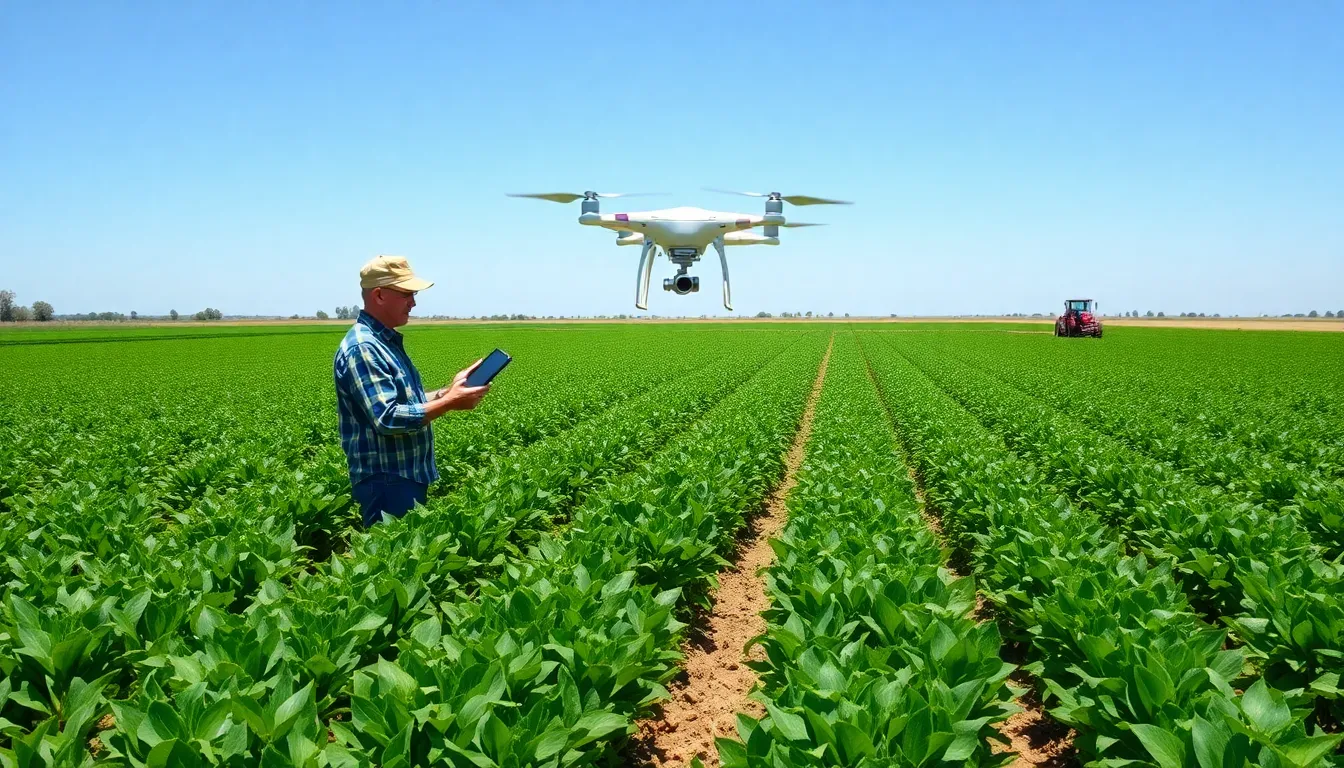In a world where technology reigns supreme, even the humble farm is getting a high-tech makeover. Smart farming technology is transforming the way crops are grown and livestock is managed, making farming not just smarter but also more efficient. Imagine drones surveying fields like high-tech hawks or sensors that know when a plant is thirsty—it’s like giving Mother Nature a smartphone!
Table of Contents
ToggleOverview of Smart Farming Technology
Smart farming technology enhances agricultural practices through advanced tools and data-driven solutions. This innovative approach employs systems like Internet of Things (IoT) sensors that gather real-time information about soil health, moisture levels, and crop conditions. Drones play a significant role by providing aerial imagery, enabling farmers to monitor large areas efficiently.
Data analytics drives decision-making processes. By analyzing collected data, farmers can optimize irrigation schedules, fertilization plans, and pest control measures. Precision agriculture emerges as a crucial component, allowing targeted application of resources based on specific field conditions.
Robotics increasingly takes the stage in smart farming. Automated machinery assists in planting, harvesting, and managing crops. Such technology reduces labor costs and improves overall productivity across various farming operations.
Mobile applications also contribute to this landscape. These platforms provide users with weather forecasts, market trends, and best practices tailored to their specific needs. As farmers access information easily, they can respond swiftly to changing conditions.
Sustainability remains a key focus. Smart farming techniques help minimize environmental impact by promoting efficient resource use. Crop rotation and smart irrigation systems exemplify practices that enhance soil health and conserve water.
Overall, smart farming technology represents the future of agriculture. As more farmers adopt these technologies, the sector stands to benefit from increased yields, reduced waste, and improved sustainability practices.
Benefits of Smart Farming Technology

Smart farming technology brings numerous advantages to modern agriculture, significantly transforming farming practices.
Increased Efficiency
Smart farming maximizes efficiency throughout the agricultural process. IoT sensors offer real-time data on soil conditions and crop health, allowing farmers to make informed decisions swiftly. Drones quickly survey vast fields, reducing the time spent on manual inspections. Automation in tasks like planting and harvesting leads to reduced labor costs and enhanced productivity. By integrating these technologies, farms operate more smoothly and with higher resource utilization.
Enhanced Sustainability
Smart farming contributes to environmental conservation and sustainability. Techniques such as precision irrigation ensure optimal water use, conserving this vital resource. Crop rotation strategies minimize soil depletion, promoting healthier ecosystems. Data analytics further supports sustainable practices by reducing chemical usage and minimizing waste, fostering eco-friendly agriculture. Such practices highlight the commitment to sustaining agricultural productivity while protecting natural resources.
Improved Crop Yields
Smart farming technology drives significant increases in crop yields. Precision agriculture techniques enable farmers to fine-tune irrigation and fertilization, catering to specific crop needs and conditions. Regular monitoring through drones and sensors helps identify issues before they escalate, maintaining optimal crop health. Consequently, farmers face fewer losses and enjoy higher quality produce. Adopting these advanced technologies translates into enhanced profitability and food security.
Types of Smart Farming Technologies
Smart farming technology incorporates various innovative tools that enhance agricultural practices and streamline operations.
IoT and Sensors
IoT and sensors play a pivotal role in smart farming. These technologies collect real-time data on soil health, moisture levels, and crop conditions. Farmers can monitor field conditions from anywhere, facilitating timely interventions. Companies like CropX and SoilMoisture utilize IoT systems to provide actionable insights. Sensors improve resource management through precision irrigation and optimize fertilizer application. Consistent data collection results in informed decision-making, enhancing overall productivity.
Drones in Agriculture
Drones are transforming how farmers monitor their fields. Equipped with advanced cameras, they capture high-resolution aerial images for detailed assessments. Farmers utilize drone imagery to identify areas needing attention, improving crop management practices. Companies such as DJI offer specialized agricultural drones for specific tasks, such as crop scouting and spraying. Timely aerial footage helps optimize inputs and ensures healthier crops, thereby boosting overall yields.
Automated Machinery
Automated machinery significantly reduces labor costs and increases efficiency on farms. Tractors and harvesters equipped with automation technologies perform tasks like planting and harvesting with minimal human intervention. Companies such as John Deere produce machinery integrated with GPS systems for precise operations. By using automated machinery, farmers achieve greater consistency in their practices and reduce operational downtime. Enhanced productivity leads to better crop quality and overall profitability.
Challenges in Adoption
Adopting smart farming technology poses several challenges that can hinder its implementation and effectiveness. Awareness of these obstacles is crucial for farmers aiming to leverage innovations.
High Initial Costs
High initial costs present a significant barrier to adopting smart farming technology. Investments in equipment, such as drones and IoT sensors, often reach tens of thousands of dollars. Farmers frequently struggle to allocate funds for these advanced tools, especially smaller operations with limited budgets. Additionally, training staff adds to the overall expenditure. Without clear financial incentives, many are hesitant to invest in technologies that may take time to yield measurable returns. Budgetary constraints can limit access to this transformative technology, delaying potential benefits.
Technological Barriers
Technological barriers complicate the adoption of smart farming solutions. Many farmers lack access to reliable internet connectivity, especially in rural areas, which limits the functionality of IoT systems. Furthermore, a noticeable skills gap exists among the workforce. Many individuals lack familiarity with advanced technologies, making it difficult to implement and operate new systems effectively. Resistance to change can also arise from traditional farming practices deeply embedded in the agricultural sector. These factors collectively create hurdles that deter farmers from fully embracing smart farming technologies.
Future of Smart Farming Technology
Smart farming technology continues to evolve, shaping the future of agriculture with groundbreaking advancements. Innovations promise greater efficiency and sustainability in farming practices.
Innovations on the Horizon
Emerging technologies hold significant potential for transforming smart farming. Advanced robotics might automate more tasks in the fields and greenhouses. Artificial intelligence enhances data analysis, predicting crop yields with accuracy. Vertical farming technologies could maximize space utilization, allowing urban areas to produce food efficiently. Furthermore, blockchain may improve traceability in supply chains, ensuring food safety and quality. As these innovations emerge, they create new opportunities for environmentally friendly farming practices.
Policy and Regulation Impacts
Policies will play a critical role in shaping the future of smart farming technology. Governments can incentivize sustainable practices through subsidies and grants for adopting smart technology. Regulations surrounding data privacy and security also need to adapt to the increasing use of IoT devices in agriculture. Transparency in data sharing protocols will be essential to build trust among farmers and tech providers. Supportive policy frameworks may encourage small farmers to adopt smart farming technologies, bridging the gap between large and small operations. Overall, well-defined regulations can foster a more equitable and innovative agricultural sector.
Smart farming technology is reshaping the agricultural landscape by enabling farmers to make informed decisions based on real-time data. These advancements not only enhance efficiency and productivity but also promote sustainable practices that benefit the environment. As the industry continues to evolve with emerging technologies, the potential for improved crop yields and resource management grows significantly.
While challenges such as high costs and technological barriers remain, the future looks promising. By fostering supportive policies and encouraging innovation, the agricultural sector can bridge gaps and ensure that smart farming technologies reach all farmers. Embracing this transformation is essential for a more resilient and productive food system.



